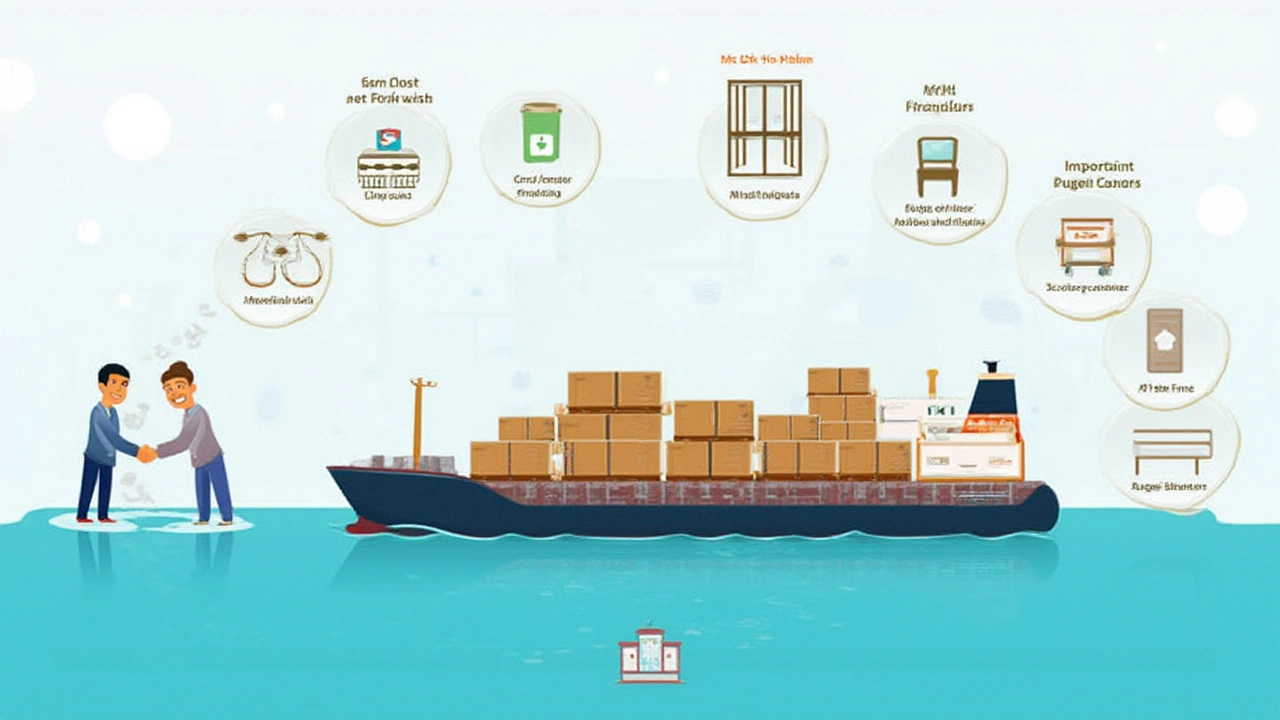 Jul, 8 2025
Jul, 8 2025
Ever strolled through a swanky New York loft and noticed a rustic, hand-carved wooden chair that’s clearly not from Ikea? India’s furniture has made its way into homes all over the US, blending artisan charm with modern tastes. The question is—how does all that heavy, gorgeous wood travel 8,000 miles, crossing regulatory minefields, dodging customs headaches, and landing safely in someone’s living room across the Atlantic? Exporting furniture from India to the USA isn’t a back-of-the-envelope affair. There’s red tape, a mountain of paperwork, standards stricter than your old headmaster, but with the right moves, even a small operation in Jaipur can capture the attention of American buyers. So, what does it actually take to make this happen?
What’s Fueling India's Furniture Export—and Why Americans Want It
Let’s start with something you might not know. India isn’t just an up-and-comer—the country ranks among the world’s top furniture exporters. According to the Indian Trade Portal, between 2020 and 2024, Indian furniture exports shot up by 25%. That’s not a blip. What’s behind this surge? American consumers have a hunger for Indian craftsmanship: think hand-carved sheesham wood, intricate bone inlay, and sustainable bamboo blends. It’s a real step up from mass-produced flat-pack furniture. US interior designers often tout Indian-made pieces as not just exotic, but built to last.
It’s not only about unique designs. Many American businesses buy from India because manufacturing costs are lower, even after you add on international freight and import duties. Plus, the Made in India label packs a story that American buyers love to tell—personalised, ethically sourced, artisan-friendly. “We’ve seen a surge in demand for Indian furniture, especially after 2020, as US customers became more focused on sustainability and authenticity,” says Richard Ross, editor at Furniture Today. The fact that Indian exporters can tap into both traditional and modern trends makes them uniquely agile in a changing market.
There’s a catch, though. The US has some of the world’s toughest furniture import regulations, and the onus is on the exporter (or their agent) to meet every one of them, from product safety to legal wood sourcing. So, who’s exporting all this furniture from India? You’ll find everything from century-old family workshops in Rajasthan to large manufacturers in Tamil Nadu using state-of-the-art machinery, bulk orders from e-commerce giants, and even individual craftsmen with Etsy shops. It’s surprisingly diverse.
If you’re thinking of getting in on this action, you’re in good company. But be ready: there’s plenty to learn and more than a little bureaucracy to wrestle.

How the Furniture Export Process Really Works—A Step-by-Step Look
The first hurdle: registration. No one’s shipping sofas as a hobby—exporters need to be officially registered with the Directorate General of Foreign Trade (DGFT) in India. Here, you’ll get your Importer Exporter Code (IEC), which is basically your ticket to the global market. Without it, customs won’t give you the time of day. Next, your furniture needs to be classified correctly according to the Harmonized System (HS) code. Get this wrong, and your shipment could be delayed for weeks, or worse—held at customs indefinitely.
Documentation is where many stumble. You’ll need a pile of paperwork, such as the commercial invoice, packing list, bill of lading or airway bill, certificate of origin (sometimes mandatory), and detailed product descriptions. Some US states, California in particular, have rules about flammability and must have the right tagging or certification. For wooden furniture, add phytosanitary certificates and evidence it’s sourced and treated according to US Department of Agriculture (USDA) and Animal and Plant Health Inspection Service (APHIS) rules. The US Lacey Act, for example, demands proof that the wood has been harvested legally—no exceptions.
The logistics aren’t trivial either. Shipping costs rose sharply after the pandemic, with a 40-foot container from Mumbai to New York now running between $3,500-$4,500 in 2025, including main sea freight, insurance, and basic handling fees. Air freight exists, but it’s rarely cost-effective for heavy pieces unless you’re selling ultra-high-value items or smaller designer runs. Sea shipping wins for bulk orders but budget at least 30-40 days door-to-door, given vessel schedules and port congestion. Here’s some useful data to put things in context:
| Step | Key Requirement | Typical Time |
|---|---|---|
| IEC Registration | One-time, online | 1 week |
| Product HS Code Classification | Accurate code selection | Same day |
| Certifications (Wood & Safety) | Sanitary, Lacey Act, Safety Labels | 2-3 weeks |
| Freight Booking | Sea or Air with reliable forwarder | 2-3 days |
| Shipping Transit | Port-to-Port/ Door-to-Door | 30-40 days (sea) |
Packaging is another make-or-break step. One bumped corner or a snapped table leg, and you’ve got an unhappy US customer plus a return that’s expensive to process. Exporters need to double box, shrink-wrap, and often palletise their shipments to reduce risk of transit damage. Insurance is a must, and it’s worth getting coverage for both product and shipping mishaps. Don’t skimp here—one incident can set you back months. For many small businesses, partnering with a reputable freight forwarder or customs agent smooths out a lot of headaches. They’ll keep tabs on local port rules, customs documentation, and tips for each US entry port, whether it’s New York, Los Angeles, or Houston.
Once your shipment reaches the US, clearing customs is about the paperwork matching perfectly and all required declarations being present (especially concerning the Lacey Act for legal wood). Any missing or inaccurate document can mean fines, penalties, or outright confiscation. Once cleared, you can deliver either to a local warehouse or directly to your buyer. Some choose to use distribution centers to help speed up final delivery, especially when selling to US retailers or e-commerce platforms.
One last step—getting paid. Letters of Credit, secure wire transfer, or verified escrow services lower financial risk, especially with new buyers. Hold off on sending the next order until payments have settled—no one enjoys chasing unpaid invoices halfway across the world.

Pro Tips, Traps to Avoid, and What the Future Holds
Everyone loves the idea of easy profits from Indian furniture exports, but as with most things, the devil is in the details. First up, stay updated on US import regulations—they change more often than you’d think, especially around product safety and environmental compliance. The Consumer Product Safety Commission (CPSC) and Environmental Protection Agency (EPA) update guidance regularly, and missing a change can mean instant rejection at the border. “You need to keep your documentation water-tight, from proof of wood origin to flammability tags, and check every box every time,” warns Priya Sharma, Director at Woodcraft Exports Ltd.
“Customs isn’t going to be flexible just because your products are handmade or beautiful. Know their rules inside out, or work with someone who does.” – Priya Sharma, Director, Woodcraft Exports Ltd.
Exporters can also trip up by underestimating the value of clear, detailed communications with American buyers. US customers expect regular updates, accurate ETAs, and total transparency on potential delays. Keep in mind, furniture buyers in the States can be extremely picky about quality—returns, bad reviews, and legal complaints can hurt your brand’s reputation quickly across online platforms like Amazon or Wayfair.
Marketing can’t be left for last, either. While you might have a strong domestic presence, breaking into the US market often requires a shift—think bilingual product descriptions, understanding American furniture trends (chunky rustic, minimal Scandinavian, industrial-chic...), and sharp, bright product photography. Display your certifications and eco-friendly credentials upfront—they matter, especially in California and big urban markets. Some exporters use third-party logistics partners (3PLs) in the US, making it easier to handle returns and after-sales support, which US buyers appreciate.
Customs duties and tariffs are critical for pricing. The typical US import duty for wooden furniture sits around 2-4%, but anti-dumping duties and special tariffs can apply to certain items. In 2023, the US temporarily increased duties on some Indian furniture categories after a spike in complaints by domestic producers. Always check current rates before quoting prices or signing a sales contract.
If you’re eager to future-proof your business, watch automation and digital supply chain management. Indian exporters who use online tracking, real-time shipment updates, and digital customs clearance tools often outperform those still buried in paper forms and manual spreadsheets. The US loves speed and accountability—if you can deliver that, you’ll stand out. Here’s a fresh example: In early 2024, a Mumbai-based company called Urban Forest boosted their US sales by 60% after switching to digital logistics and real-time container tracking, slashing missed deadlines and lost shipments.
As eco-regulations tighten, sustainable sourcing will become more than a sticker on the box. US buyers already look for FSC (Forest Stewardship Council) certification and low-VOC (volatile organic compound) finishes. It’s not just a trend but a requirement in some states, so invest early. Even small exporters find US buyers more willing to pay a premium for guaranteed eco-friendly products.
In the end, the answer to the big question—can you export furniture from India to the USA?—is a clear yes, but only if you play smart. It’s a marathon, not a sprint. Get your registrations sorted, stay glued to the regulations, and think of logistics as the backbone of your export business. The appetite for high-quality, unique Indian furniture is only set to grow in the States, and with every regulation you master, you’re that much closer to seeing a new creation land proudly in someone’s home across the globe.